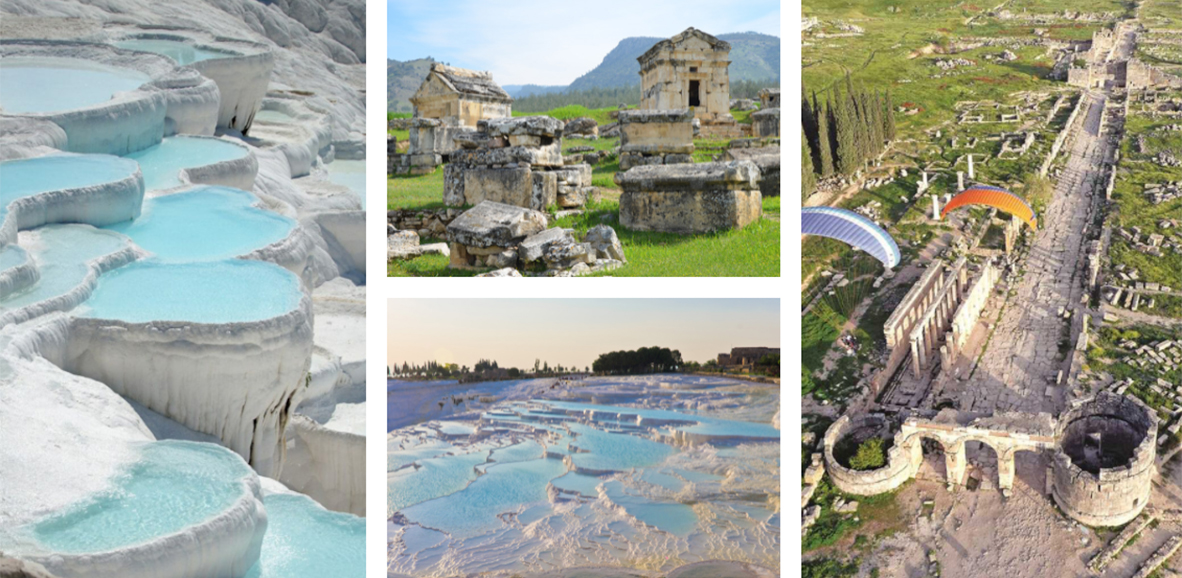The ancient city of Hierapolis, located in modern-day Pamukkale, southwestern Turkey, is approximately 6 miles (10 km) north of the ruins of Laodicea. It is about 580km far from Istanbul and there are direct flights everyday from Istanbul to Denizli Airport.
Situated on the Coruh River, a tributary of the Buyuk Menderes (Maeander) River, it was probably established by Eumenes II of Pergamum in 190 BC. It became a holy city (hieron), and its main religious celebration was the Letoia, in honor of the goddess Leto, a local version of the Great Mother of the Gods, who was worshipped with orgiastic ceremonies.
There was also an oracle of Apollo Lairbenos. In approximately AD 14–37, the Roman emperor Tiberius rebuilt Hierapolis, which survived until 1334, when it was destroyed by an earthquake. Baths, a gymnasium, an agora, and a Byzantine church are among the ruins that have been excavated since the 19th century. In 1988, Hierapolis was designated a UNESCO World Heritage site.
The therapeutic sulphur springs have been utilized as a spa since the 2nd century BC, and many individuals have retired or died there. The huge necropolis is packed with sarcophagi, notably that of Marcus Aurelius Ammianos, which features a sculpture depicting the world’s first known crankshaft and rod mechanism. On the pediment, a waterwheel fed by a mill race drives two frame saws that cut rectangular blocks via connecting rods and cranks.
The magnificent baths were built using massive stone blocks without the use of cement and included various enclosed or open areas interconnected together. There are numerous inner niches, including the bath chamber, library, and gymnasium.
According to ancient tradition, Philip the Apostle was beheaded in Hierapolis around the year 87 during the reign of Emperor Domitian. As a metropolis as well as a bishopric, Hieropolis remained one of Phrygia Pacatiana’s two metropolises. The cathedral, baptistry, and churches are among the Christian monuments. St Philip’s martyrion is noteworthy for its octagonal construction.
It has been discovered in excavations at the Hierapolis Ancient City that Hell’s Gate and the opening to a cave, which was considered -at the time of ancient pagan beliefs- to be a ‘gateway between life and death,’ were found. This location is known as Plutonium Sanctuary and you can visit this place when you are there.
Cleopatra Pool, which is believed that she bathed here once, is another important place to visit in Hierapolis Ancient city. The thermal pool’s water is 36–57°C, with a pH of 5.8. The spa water comprises bicarbonate, sulphate, carbon dioxide, iron, and a radioactive mixture. The water from this spring may be used for bathing and drinking treatments because it has a melting metal value of 2430 mg/liter. There is no fee to enter the garden and sit beside the pools if you are not swimming. If you wish to swim in the pool, you must pay the entrance fee of 50 Turkish Lira per person. You should bring your swimsuit for the pool.
The entrance fee for Hierapolis Ancient City and Pamukkale Travertine Terraces is 110 Turkish Lira per person until April 2022.
Please click here to get more information about Hierapolis Ancient City



Comment (0)